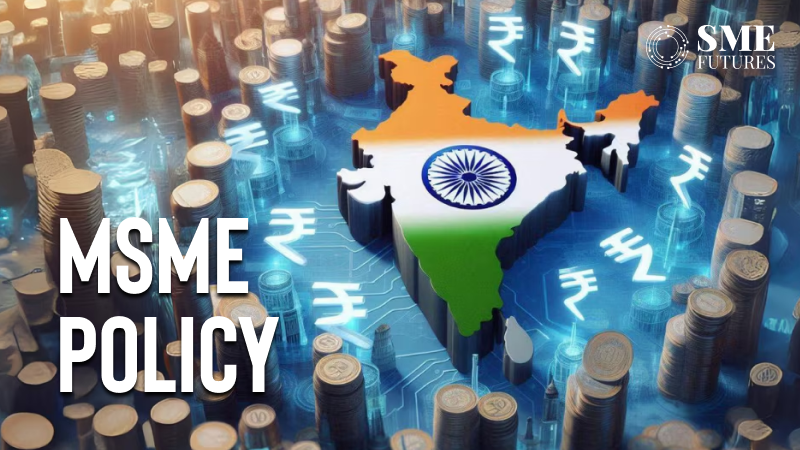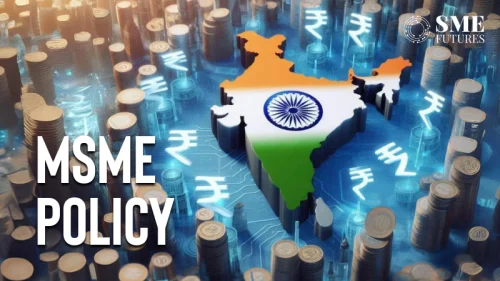The rapidly evolving Indian SME market holds significant potential, driven by the growth of the Indian economy and the increasing adoption of e-paper workflows and digital services. As SMEs in India embrace new technologies and transition their processes to the cloud, daily operations are becoming more streamlined, allowing businesses to concentrate on expansion. Furthermore, the ongoing digitisation of government services, coupled with initiatives focused on SMB growth, is enhancing the efficiency of B2G and G2B interactions, further contributing to the sector’s promising future.
Under the Atmanirbhar Bharat Abhiyaan (Self-Reliant India) campaign, the micro, small, and medium-sized Enterprises (MSMEs) contributed around 30 per cent to the GDP in the year 2021–2022 and employed over 11 crore persons in India during the same period. The rapidness in growth has made MSMEs the backbone of the Indian economy.
Post-COVID, the MSME sector has shown remarkable resilience. India now has around 63 million MSMEs, with 45 per cent contributing to the country’s total exports. To support these vital businesses, the Government of India has launched several policy initiatives focusing on financial aid and digitization, ensuring their sustainability and reinforcing their crucial role in the economy.
India’s MSME landscape
India’s MSME is an ever-evolving sector that includes a wide range of industries, from old-school crafts to high-tech startups. The number of MSMEs in the country is expected to grow from 6.3 crore, to ~7.5 crore in the coming times, growing at a projected CAGR of 2.5 per cent. This growth has boosted both local demand and export opportunities, playing a significant role in driving India’s economy forward.
According to the Ministry of Commerce and Industry, 10,000 startups were recently approved in just 156 days, compared to the initial 10,000 approvals which took 808 days. Notably, Tier-2 and Tier-3 cities now account for 49 per cent of these startups.
Positive aspects of MSMEs in India
Over the years, India’s MSME policy has evolved significantly, demonstrating a commitment to enhancing the sector’s capabilities and competitiveness. Key positive aspects include:
1. Improved financial support
Traditionally, MSMEs struggled to secure financial support due to limited credit from banks and high collateral requirements. New programs like the Credit Guarantee Fund Scheme (CGS) and the Pradhan Mantri Mudra Yojana (PMMY) have transformed this landscape. CGS has guaranteed loans worth over ₹5.5 lakh crore, assisting more than 1.5 crore MSMEs in obtaining credit. PMMY has approved loans exceeding ₹6.5 lakh crore, benefiting 40 million businesses.
2. Simplified registration and compliance
Previously, MSME registration and compliance involved excessive red tape. The Udyam Registration Portal has streamlined this process, with over 7 million MSMEs now registered. This simplification reduces unnecessary paperwork and facilitates access to various government schemes and subsidies.
3. Sector-specific support
Earlier policies often lacked the detail needed to address the unique needs of different MSME sectors. New policies have introduced focused support programs. The Stand Up India Scheme provides loans to SC/ST and women entrepreneurs, while the Production Linked Incentive (PLI) Scheme boosts manufacturing and exports.
Financial aid provided to MSMEs in India
India is a developing nation and there are various needs in our economy for substantial growth, and India’s Union Budget 2024–25, presented by Finance Minister Nirmala Sitharaman, proposed key measures to support MSMEs, addressing various needs from startup funding to operational credit:
1. Credit Guarantee Scheme
● Provides collateral-free loans up to ₹500 lakh to MSMEs.
● Offers guarantee coverage up to 85 per cent for loans to women, enabling MSMEs to purchase machinery and equipment without collateral or third-party guarantees.
2. New Assessment Model
Public sector banks will develop a new credit assessment model, enhancing their internal capacity to evaluate MSMEs for credit, reducing dependency on external assessments.
3. Credit Support
A government-sponsored fund will offer credit support to MSMEs during stressful phases, ensuring the continuation of bank credit throughout difficult times.
4. Mudra loans
The maximum amount of Mudra loans under the “Tarun” category will be increased to ₹20 lakh from the current ₹10 lakh for business owners who have successfully repaid prior loans.
5. MSME champions
● This scheme offers a bank-financed subsidy program for setting up new micro-enterprises in the non-farm sector.
● Provides a margin money subsidy on bank loans ranging from 15 per cent to 35 per cent.
6. MSME loan scheme 2024
The MSME Loan Scheme 2024 provides a 90 per cent guarantee for the sub-debt, with the remaining 10 per cent from the promoters. The maximum tenure for repayment is ten years. Key MSME loan schemes include:
● Pradhan Mantri Mudra Yojana (PMMY)
● Credit Guarantee Trust Fund for Micro & Small Enterprises (CGT MSE)
● Credit Linked Capital Subsidy Scheme (CLCSS)
● Equity Infusion for MSMEs through Fund of Funds
● Credit Guarantee Scheme for Subordinate Debt (CGSSD)
● SIDBI Make in India Loan for Enterprises (SMILE)
7. Marketing assistance scheme
Provides assistance for participation in international exhibitions and trade fairs abroad.
8. International cooperation scheme
Offers assistance for international events held both in foreign countries and India.
9. E-Commerce export hubs
Establishes E-Commerce Export Hubs in public-private partnership (PPP) mode to enable MSMEs and traditional artisans to sell their products internationally. These hubs will provide trade and export-related services under one roof with a streamlined regulatory and logistic framework.
Comparison to global MSME policies
When compared to global MSME policies, India’s approach exhibits both unique strengths and commonalities with other economies. The European Union, for instance, places a strong emphasis on fostering innovation and research by offering substantial grants and subsidies through programs like Horizon Europe. This initiative is designed to support small businesses in developing cutting-edge solutions, making them more competitive in the global market. In contrast, India prioritizes financial inclusion for microenterprises through initiatives like the MUDRA scheme, ensuring that even the smallest businesses have access to credit and growth opportunities.
Similarly, in the United States, the government provides loan guarantees and grants via the U.S. Small Business Administration (SBA), which functions similarly to India’s Credit Guarantee Fund Trust for Micro and Small Enterprises (CGTMSE). While both countries focus on enabling financial support for MSMEs, India’s unique strength lies in the extensive reach of the MUDRA scheme, which provides micro-financing at a scale that has no direct parallel in the U.S. This initiative has been instrumental in empowering small entrepreneurs, particularly in rural and semi-urban areas, where access to formal credit was previously limited.
Another key difference is in digital infrastructure. The U.S. boasts a highly mature digital ecosystem, with seamless integration of technology in business operations, financing, and market access. On the other hand, India has recently intensified its efforts to drive MSME digital adoption through initiatives such as Digital India and the Digital MSME Scheme. These policies aim to bridge the technological gap, enabling small businesses to leverage digital payments, e-commerce platforms, and cloud-based solutions. While India still has a long way to go in terms of digital penetration across all MSMEs, the recent policy-driven momentum signifies significant progress toward a more tech-enabled small business ecosystem.
Technology adoption for MSMEs
Recent policy initiatives have significantly enhanced technology adoption among Indian MSMEs. The Digital India initiative, launched in 2015, aims to improve both digital infrastructure and literacy. A report indicates that driven by such initiatives, over 50 per cent of MSMEs adopted digital technologies by 2023, up from 35% in 2015. Policies like subsidies for IT infrastructure under the Digital MSME Scheme have facilitated businesses’ transition towards e-commerce, digital payments, and cloud solutions.
In fact, cloud-based SaaS solutions offer numerous advantages, including saving time, money, and human resources, securely managing large volumes of data, and providing remote access from anywhere. These solutions also automate routine tasks, freeing up time for strategic planning, and reduce entry barriers for small and family-owned businesses. As cloud software becomes more affordable, it is rapidly becoming a widely accessible tool for businesses of all sizes.
Growth outlook
The future is poised to favor small entrepreneurs in both the manufacturing and service sectors. This outlook encompasses the expansion of established companies as well as the emergence of new startups. Growth is expected in complex manufacturing businesses and service-oriented enterprises like quick commerce.
Additionally, there is significant growth in outsourcing companies that supply IT specialists for global project work, along with accounting firms, reflecting a broader shift towards specialised service industries.
Several factors contribute to the confidence in the growth of small and medium-sized businesses in India. First, rising unemployment is motivating university graduates to launch their own ventures, creating new employment opportunities in the process.
Second, societal perceptions of entrepreneurship have shifted significantly in recent years. What was once met with skepticism, with entrepreneurial efforts often dismissed as not “real work,” has now gained widespread recognition, thanks in part to the rise of business culture and popular shows like Shark Tank, which have brought entrepreneurs into the spotlight.
Third, India’s emerging middle class is increasingly eager not only to purchase products but also to invest in related services. This rising domestic demand is further bolstered by government policies designed to support and protect economic growth.
As the MSME landscape continues to grow, driven by technological adoption and government policies, it is poised to remain a key contributor to India’s economy, supporting both local demand and global export opportunities.











